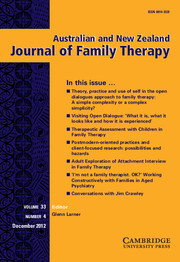Article contents
Mitigating Intergenerational Trauma Within the Parent-Child Attachment
Published online by Cambridge University Press: 03 August 2012
Abstract
Nine-year-old Ben was said to hate women. His mother was terrified he'd ‘grow up a woman basher’. This paper describes the work done with Ben and his family at the Hobart Child and Adolescent Mental Health Service. We drew predominantly on three therapeutic modalities: Theraplay, Family Attachment Narrative Therapy and Dyadic Developmental Psychotherapy. Our work enabled Ben's mother to navigate the aftermath of her own trauma history in order to heal Ben's attachment trauma.
- Type
- Articles
- Information
- Australian and New Zealand Journal of Family Therapy , Volume 33 , Issue 2 , June 2012 , pp. 114 - 127
- Copyright
- Copyright © The Authors 2012
References
Ainsworth, M. D. S. (1979). Infant-Mother Attachment. American Psychologist, 34 (10): 932–937.CrossRefGoogle ScholarPubMed
American Psychiatric Association (1994). Diagnostic and statistical manual of mental disorders (4th ed.), Washington DC.Google Scholar
Becker-Weidman, A. (2005). Dyadic Developmental Psychotherapy: The theory, in Becker-Weidman, A. & Shell, D. (Eds.), Creating capacity for attachment: Dyadic Developmental Psychotherapy in the treatment of trauma disorders, Oklahoma City: Wood N Barnes.Google Scholar
Cozolino, L. (2002). The neuroscience of psychotherapy: Building and rebuilding the human brain, New York: W.W. Norton.Google Scholar
Doidge, N. (2007). The brain that changes itself: Stories of personal triumph from the frontiers of brain science, New York: Penguin.Google Scholar
Fonagy, P., Steele, H., Moran, G. S., Steele, M., & Higgit, A. (1991). The capacity for understanding mental states: The reflective self in parent and child and its significance for the security of attachment, Infant Mental Health Journal, 12 (3): 200–217.3.0.CO;2-7>CrossRefGoogle Scholar
Hesse, E. (1999). The adult attachment interview: Historical and current perspectives, in Cassidy, J. & Shaver, P. R. (Eds.), Handbook of attachment: Theory, research and clinical applications, New York: Guilford Press.Google Scholar
Hesse, E., & Main, M. (2006). Frightened, threatening, and dissociative parental behavior: Theory and associations with parental adult attachment interview status and infant disorganization, Development and Psychopathology, 18, 309–343.Google Scholar
Hughes, D. A. (1997). Facilitating developmental attachment: The road to emotional recovery and behavioural change in foster and adopted children, Lanham, Rowman & Littlefield.Google Scholar
Hughes, D. A. (2005). An attachment-focused treatment for foster and adoptive families, British Psychological Society Service and Practice Update, 4 (4): 26–28.Google Scholar
Jernberg, A. M., & Booth, P. B. (2001). Theraplay: Helping parents and children build better relationships through attachment-based play, San Francisco: Jossey Bass.Google Scholar
Lacher, D., Nichols, T., & May, J. (2005). Connecting with kids through stories: Using narratives to facilitate attachment in adopted children, London: Jessica Kingsley.Google Scholar
Lender, D. (2006). What's behind these Theraplay activities: A window into attachment, Theraplay Institute Newsletter, Summer 2006, http:/www.theraplay.org/articles/06_sum_Lender.pdfGoogle Scholar
Lyons-Ruth, K., & Jacobvitz, D. (1999). Attachment disorganization: Unresolved loss, relational violence, and lapses in behavioural and attentional strategies. In Cassidy, J. & Shaver, P. R. (Eds.), Handbook of attachment: theory, research and clinical applications, New York: Guilford Press.Google Scholar
Main, M., & Cassidy, J. (1988). Categories of response to reunion with the parent at age 6: Predictable from infant attachment classifications and stable over a 1 month period, Developmental Psychology, 24 (3): 415–426.CrossRefGoogle Scholar
Marvin, R., Cooper, G., Hoffman, K., & Powell, B. (2002). The circle of security project: Attachment-based intervention with caregiver-preschool child dyads, Attachment & Human Development, 4 (1): 107–124.CrossRefGoogle Scholar
May, J. C. (2005). Family attachment narrative therapy: Healing the experience of early childhood maltreatment, Journal of Marital and Family Therapy, 31 (3): 221–237.CrossRefGoogle ScholarPubMed
Perry, B. D. (2009). Examining child maltreatment through a neurodevelopmental lens: Clinical applications of the neurosequential model of therapeutics, Journal of Loss and Trauma, 14, 240–255.CrossRefGoogle Scholar
Perry, B. D., Pollard, R. A., Blakley, T. L., Baker, W. L., & Vigilante, D. (1995). Childhood trauma, the neurobiology of adaptation, and use-dependent development of the brain: How states become traits, Infant Mental Health Journal, 16 (4): 271–291.3.0.CO;2-B>CrossRefGoogle Scholar
Perry, B. D., & Szalavitz, M. (2006). The Boy who was raised as a dog: and other stories from a child psychiatrist's notebook: What traumatized children can teach us about loss, love and healing, New York: Basic Books.Google Scholar
Porges, S. W. (2003). Social engagement and attachment: a phylogenetic perspective, Annals of the New York Academy of Sciences, 1008, 31–47.CrossRefGoogle ScholarPubMed
Schore, A. N. (2001a). Effects of a secure attachment relationship on right brain development, affect regulation and infant mental health, Infant Mental Health Journal, 22 (1–2): 7–66.3.0.CO;2-N>CrossRefGoogle Scholar
Schore, A. N. (2001b). The effects of early relational trauma on right brain development, affect regulation, and infant mental health, Infant Mental Health Journal, 22 (1–2): 201–269.3.0.CO;2-9>CrossRefGoogle Scholar
Siegel, D. (1999). The developing mind: Toward a neurobiology of interpersonal experience, New York: Guilford Press.Google Scholar
Sroufe, L. A. (2000). Early relationships and the development of children, Infant Mental Health Journal, 21 (1–2): 67–74.3.0.CO;2-2>CrossRefGoogle Scholar
Sroufe, L. A. (2005). Attachment and development: A prospective longitudinal study from birth to adulthood, Attachment & Human Development, 7 (4): 349–367.CrossRefGoogle ScholarPubMed
Trevarthen, C., & Aitken, K. J. (2001). Infant intersubjectivity: Research, theory and clinical applications, The Journal of Child Psychology and Psychiatry, 42 (1): 3–48.CrossRefGoogle ScholarPubMed
Van der Kolk, B. A. (2005). Developmental trauma disorder: A new rational diagnosis for children with complex trauma histories, Psychiatric Annals, 35 (5): 401–408.CrossRefGoogle Scholar
Zeanah, C. H., & Boris, N. W. (2000). Disturbances and disorders of attachment in early childhood, in Zeanah, C. H. (Ed.), Handbook of infant mental health (2nd ed.), New York: Guilford Press.Google Scholar
Zilberstein, K., & Messer, E. A. (2010). Building a secure base: treatment of a child with disorganised attachment, Clinical Social Work Journal, 38, 85–97.CrossRefGoogle Scholar
- 11
- Cited by




